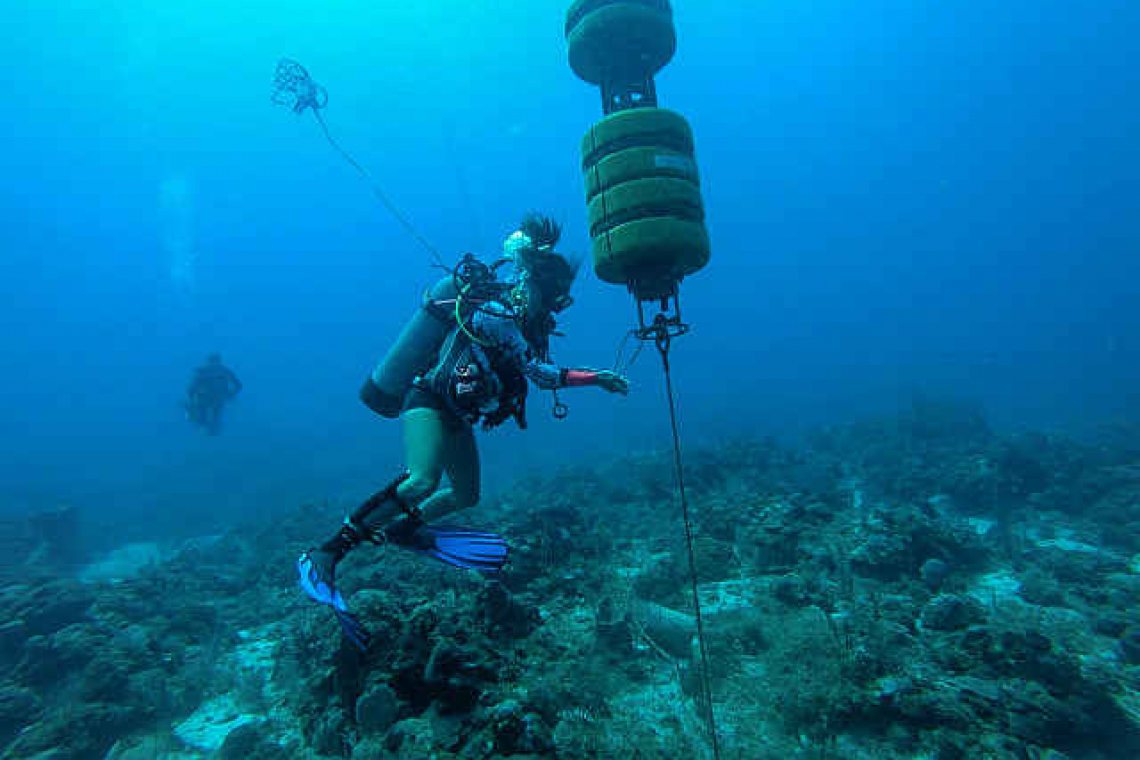Underwater microphones in the Saba Bank record sounds of a variety of marine species, from whales and dolphins to schools of fish. Photo by Ayumi Kuramae. Izioka).
PHILIPSBURG--The Saba Bank noise logger research project has been collecting acoustic data of marine mammals, fish and man-made noises in the Saba Bank since 2011.
This project, a collaborative effort of Wageningen Marine Research and Saba Conservation Foundation, is providing critical data to identify how and when important marine species use these waters. This information is key for creating and implementing effective conservation plans, it was stated in a press release from the Dutch Caribbean Nature Alliance (DCNA).
The Saba Bank is home to a diverse population of marine mammals. For many of these species, this area serves as a primary habitat for critical activities that include feeding, mating and calving. This is particularly true for a variety of dolphin and whale species.
Historically, these species have been hard to track, as researchers often depend on visual sightings by fishermen or tourists to detect their presence. However, technological developments are now allowing researchers to listen and record underwater sounds, giving an unprecedented look into these animals’ lives.
Yarari Sanctuary
Saba Bank has been a part of Yarari Marine Mammal and Shark Sanctuary since 2015. The sanctuary includes all the waters of Bonaire and Saba, and since September 2018, St. Eustatius. The sanctuary was established to help protect the marine mammals and sharks around the Dutch Caribbean. The first step in protecting these waters is to support and promote projects that work to identify the species that can be found here.
Many marine mammals rely on acoustics for spatial orientation, communication, mate attraction and foraging. Each species has the ability to create unique vocalisations and can often adapt these sounds based on conditions of background noise or distance to their targeted audience. Man-made noise can have a variety of negative impacts on marine mammals that can cause confusion, stress or changes in behaviour.
Saba Bank noise logger project
Starting in 2011, the Saba Bank noise logger project has provided valuable information in support of conservation efforts by identifying the specific whale species that can be found on the Saba Bank. Hydrophones (underwater microphones) can record continuously for six months at a time, and give researchers the ability to listen to a variety of marine species, from whales and dolphins to schools of fish.
Noise loggers detect all ambient noise, including natural background noise produced by tidal current and waves, noise from marine animals such as fish or crustaceans (snapping shrimp) and anthropogenic noise from shipping, seismic operations and naval sonar. Then using the different sounds and frequencies, researchers are able to distinguish species, and their relative occurrence over time.
The project, commissioned by the Dutch Ministry of Agriculture, Nature and Food Quality, is a collaborative effort of Wageningen Marine Research and Saba Conservation Foundation, and is supported by international partners such as Scottish Association for Marine Science (SAMS), the United States National Oceanic and Atmospheric Administration (NOAA), and the Caribbean marine mammals preservation network CARI’MAM.
The goal is to identify the temporal occurrence of cetaceans and where possible their acoustic behaviour (e.g. “singing”), and identify any other sounds of marine animals which can be detected in the Saba Bank. This information will help conservationists and policy-makers to draft effective management plans for endangered species in this region.
Results
The project was successful at detecting marine mammals such as dolphins, humpback whales and minke whales. It helped to better understand the migratory patterns of minke whales by comparing recordings in the Caribbean with other areas in the Northwest Atlantic.
However, this information is only a small piece of the puzzle. The songs produced by males humpback whales can be further investigated to identify individual and local differences. Migratory patterns of humpback whales, both from their feeding grounds to the Caribbean as well as within the wider Caribbean, can be further investigated by linking data collected from other hydrophone stations.
In the future, detection rates of cetaceans could also be used in combination with visual surveys to improve the understanding of local densities and, in the long run, possibly population sizes.
Overall, the project has provided important insight to cetaceans using the Saba Bank, it was stated in the release. Along with providing critical research and data to help support conservation efforts, this information could also help to develop a new economic source for the island. If the presence of whales and dolphins is better understood and can be predicted, sustainable marine mammal watching tours could be a new and popular tourist attraction for Saba.
“It is important that all stakeholders on the island work together to ensure these important species are protected and respected, while also working to enhance the lives of the local population,” it was stated in the release.
Report sightings
The public is urged to report any sightings or photos they may have of marine mammals or other species, at
https://dutchcaribbean.observation.org. This is a free website and app (iPhone (iObs) and Android (ObsMapp)) which allows scientists, citizens and tourists to report sightings of important plants and animals.
These tools are available in more than 40 languages and can be used by biologists, citizens and tourists. Species reports by local communities are invaluable for nature conservation efforts to help increase public awareness and overall species protection.
Observation.org is also working together with Naturalis Biodiversity Center on automated species identification software. “Your uploaded photos are of great value to make this possible.” For questions, contact
This email address is being protected from spambots. You need JavaScript enabled to view it.







